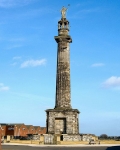Britannia Monument
Archaeology »
Archaeological Monuments » Britannia Monument
Britannia Monument - United kingdom
Britannia Monument is located in Norfolk, England.
Britannia Monument monument was established on 1817-1819.
Primary threats to Britannia Monument :
The first custodian of the monument was former Able Seaman James Sharman, a member of the crew of the Victory from Norfolk and one of those who carried Nelson below decks after he was shot.
Historical facts of Britannia Monument :
The Britannia Monument, also known as the Britannia Obelisk, is a historic landmark located in Great Yarmouth, Norfolk, England. Standing proudly at the heart of the town, this monument holds significant historical importance and serves as a symbol of the town's maritime heritage. Here are some key historical facts about the Britannia Monument:
- Construction and Purpose :
The Britannia Monument was constructed in 1817 to commemorate the victories of the British Navy during the Napoleonic Wars. It was designed by architect William Wilkins and stands at an impressive height of 144 feet (44 meters). The monument's purpose was to honor the brave men who fought for the nation's maritime dominance and to celebrate Britain's naval power.
- Naval Symbolism :
The monument's design is laden with naval symbolism. It takes the form of an obelisk, which was a common architectural feature in ancient Egypt and associated with strength and stability. The obelisk represents the maritime strength of Great Britain and its dominance over the seas.
- Architectural Details :
The Britannia Monument features several intricate architectural elements. At the top of the obelisk stands a female figure, representing Britannia, the personification of Britain. She holds a trident in one hand, symbolizing naval power, and a wreath in the other, representing victory. The monument is adorned with various nautical motifs, including anchors and chains, further emphasizing its maritime theme.
- Dedication Ceremony:
The monument was officially dedicated on 4th July 1819, in a grand ceremony attended by prominent local dignitaries and naval officers. A parade was held, and the monument was unveiled to the public amidst great celebration. The dedication ceremony served as a patriotic display and a tribute to the nation's naval heroes.
- Restoration and Preservation :
Over the years, the Britannia Monument has undergone several restoration projects to maintain its structural integrity. In 1978, it was designated a Grade I listed building, recognizing its historical and architectural significance. Efforts have been made to ensure its preservation and to safeguard it for future generations.
- Landmark and Tourist Attraction :
The Britannia Monument has become an iconic landmark and a popular tourist attraction in Great Yarmouth. Visitors can climb the 217 steps to reach the viewing platform at the top, which offers panoramic views of the town and the surrounding coastline. The monument provides a unique vantage point and serves as a testament to the town's rich maritime heritage.
- Commemorative Inscriptions :
The base of the monument features commemorative inscriptions honoring the naval victories and the commanders who led the British Navy to triumph. It pays tribute to notable figures such as Admiral Lord Nelson, who played a pivotal role in securing Britain's naval dominance during the Napoleonic Wars.
- Restoration Efforts in the 21st Century :
In recent years, the Britannia Monument underwent significant restoration work. In 2017, to mark the bicentennial of its construction, a restoration project was initiated to repair and refurbish the monument. This included repairs to the stonework, cleaning, and repainting of the ironwork, and the installation of new lighting to enhance its visibility at night.
- The Britannia Monument stands as a proud testament to Great Britain's maritime history and the bravery of its naval forces. Its iconic presence in Great Yarmouth continues to inspire awe and serves as a reminder of the nation's naval heritage.

